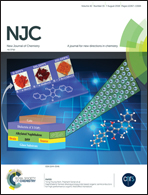Copper (ii) dimers stabilized by bis(phenol) amine ligands: theoretical and experimental insights†
Abstract
Using deprotonated forms of tetradentate bis(phenol) amine ligands 2-(((3,5-di-tert-butyl-2-hydroxybenzyl)(2-hydroxyethyl)amino)methyl)-4,6-di-tert-butylphenol (2LH2) and newly synthesized methyl-2-(bis(3,5-di-tert-butyl-2-hydroxybenzyl)amino) propanoate (1LH2), dinuclear copper(II) complexes were synthesized. These ligands yielded two dinuclear complexes of composition [(nL)2CuII2] [n = 1, (1) and n = 2, (2)], which have been characterized using X-ray crystallography, UV-Vis spectroscopy and magnetic susceptibility measurements. The phenolate moieties of the copper complexes were electrochemically oxidized to phenoxyl radicals. The antiferromagnetic exchange coupling of the two copper centers of these complexes was investigated by magnetic susceptibility (2–300 K) measurements. The weak exchange coupling constant (J) of the complexes, compared to the literature values, is attributed to the smaller Cu⋯Cu distance and Cu–O(Ph)–Cu angle. [1LCuII(py)] (4) and [2LCuII(py)] (5) showed rhombic spectra typical of the d9 configuration. The dimer complex can be converted into the corresponding monomeric Cu(II) complex, [1L2CuII2(X)] (X = py), by adding an exogenous ligand such as pyridine (py) into a CH2Cl2 solution of the dimer. All EPR spectra were simulated and analyzed. The cyclic voltammograms observed with 1L2Cu2 and 2L2Cu2, revealed two oxidations with a similar minute difference in their redox potentials. Since copper(II)-oxidation is not feasible at such low potentials, these redox processes were assigned to ligand-centered oxidation yielding a phenoxyl radical in the complex. Density Functional Theory (DFT) at the B3LYP level and Time-Dependent (TD)-DFT calculations rationalize the electronic structures of the complexes and throw light on the origin of the observed electronic transitions.



 Please wait while we load your content...
Please wait while we load your content...